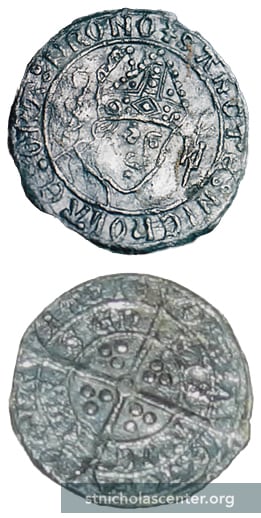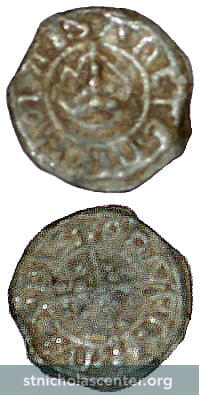Medieval Boy Bishop Tokens
from "The Festival of the Boy Bishop in England" by Edward F. Rimbault
Lead boy bishop tokens have the image of the boy bishop, or a miter representing him, on one side and a long-armed cross, with three gold balls for Nicholas, on the other. Inscriptions include SANCTE NICOLAE (Saint Nicholas), ORA PRO NOBIS (pray for us), and AVE REX GENTIS ANGLORUM (Hail King of the English People). The quantity of these tokens attests to the popularity of the festival.
 Bury St. Edmunds, Suffolk, EnglandSt Nicholas Center Collection |
 Found near Norwich, EnglandSt Nicholas Center Collection |
The question of money struck for the boy -bishop—"St. Nicholas' pence"—is thus summed up in a MS. note by Mr. Nichols: "The only place in this country where I have detected any evidences of such imitative coinage is Bury St. Edmund's.
The money of the Archbishops of Canterbury and York, the Bishop of Durham, and the Abbot of Reading, was distinguished from that of our Edwards, Henries, and Richards, by a simple mint-mark only. The Abbot of St. Edmundsbury, in imitation of whose right of coinage these tokens were probably issued, is not known to have placed any distinguishing mark upon his coins. In France, where almost every prelate and baron was allowed to strike money in his own name, we find the names of the Bishops of Innocents, and of Fools, similarly commemorated upon their pseudo- coinage. In England, on the contrary, where all the current coin of the realm was impressed with 'the image and superscription' of the reigning King, and where also the ceremony of the boy- bishop was more exclusively a religious ceremony, the name of St. Nicholas appears on the tokens issued in commemoration of this festival, and that of the infant prelate is lost.
It was possibly the practice to sink a new die each year for this coinage, which will account for the varieties of type that are found; and it may have been from design, rather than accident, that some were thrown behind the stalls of the church.
There are, however, other similar tokens, which we can scarcely appropriate to the festival of the boy-bishop, though they may have been struck for other festivals of a similar character. One bears a mitred head between the letters s and M, with the legend SANCTE MARTINE ORA PRO, and on the reverse a shield charged with a chevron between them, and the legend GRATIA DEI SVM ADSVM. See also in Kigollot's work, p. 96, SANCTE AUGUSTINE ORA PRO NOBIS.
With respect to Mr. Roach Smith's suggestion that these were commemorative 'medals of presence,' it is to be remembered that the pilgrims' tokens, of which so many have been recovered in recent reseaches, were usually fastened on the cap or garment, and only figured on one side. These tokens, on the contrary, are evidently struck in imitation of money, and were, therefore, probably intended to be so regarded, at least in sport.
From Edward F. Rimbault's introduction to Two Sermons Preached by the Boy Bishop at St. Paul's, Temp. Henry VIII, and at Gloucester, Temp. Mary, John Gough NIchols, editor, Camden Society, 1875, Internet Archive.

